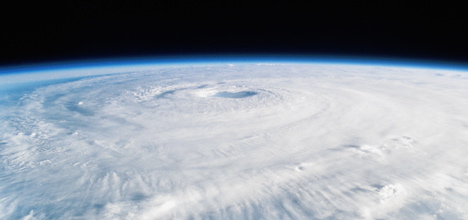More People, More Problems: Future-Proofing our Cities

By: Mark Tercek & Laura J. Huffman
In 2012, Hurricane Sandy wreaked havoc on the New York metropolitan area, causing the East River to overflow its banks and inundate much of Lower Manhattan. A record 14-foot storm surge was recorded at Battery Park and the city and its suburbs experienced massive power outages and a complete breakdown of mass transit service. Mayor Michael Bloomberg assessed the damage at more than $80 billion, making Sandy the second costliest hurricane in United States history, after Hurricane Katrina in 2005.
The persistent drought in Texas, which began in 2011 and continues today, has affected everything from its legislative priorities to its agricultural industry to the state’s expansive tree canopy—and the latter is a problem that could take generations to undo. More than 60 million of Greater Houston’s 663 million trees died as a result of the drought, including 50 percent of the tree canopy in the city’s beloved 1,400+-acre Memorial Park.
In mid-2013, floods in central Europe killed at least 23 people, causing close to $22 billion in economic losses and as much as $5.3 billion in insured losses. It has been deemed the costliest natural disaster of the year thus far.
These are not isolated events, but just a few of too many examples that illustrate the perils of an increasingly frequent one-two environmental punch: extreme weather trends combined with a rapidly growing urban population. What is happening and what can we do about it?
Several global megatrends are reshaping how cities think about and rely on natural resources.
A Booming Population and Rapid Urbanization
The United Nations projects the world’s population will jump from seven billion to more than nine billion over the next 50 years, with three out of every five people living in an urban area. That will put unprecedented pressures on already aging and crumbling infrastructure. We already see evidence of this across the U.S. Every four years, the American Society of Civil Engineers releases a comprehensive assessment of the country’s infrastructure—its roads, bridges, dams, levees and water pipelines. Grades in 2013 ranged from a high of B- for solid waste to a low of D- for inland waterways, with the average coming in at a D+.
What can cities do to raise these grades? They cannot afford to rely solely on traditional solutions. Building our way out of the challenges surrounding rapid population growth and urbanization simply isn’t cost-effective—the ASCE estimates the government would need to invest $3.6 trillion by 2020 to upgrade existing infrastructure. And that figure doesn’t account for the new infrastructure needed to support growing cities.
Global Responses
Fortunately, nature can help solve these problems, add important compounding benefits for nature and people, and potentially reduce the cost of addressing these challenges. Natural systems—things like healthy trees and intact coastal wetlands—have the capacity to reduce pollutants in the air, clean and maintain water supplies, and protect us from storms and hurricanes. They are tangible assets that contribute to our economy, so we must invest in them wisely to secure our shared future. And we need to invest on a scale that makes a difference. We cannot combat problems like extreme weather, aging infrastructure and population growth with small thinking. Science and experience have shown us that protecting small, fragmented parcels of land or portions of rivers will not move the conservation ball forward.
So what will?
Urban Water Management
Water is about securing our collective good fortune. Over the next 20 to 30 years, 70 percent of the world’s population will live in an urban area of 10 million or more. More people in our cities will equal more demand for water, energy and food, not to mention the necessary infrastructure and economic development to support such demands. Conservation will be the key to tackling this issue—it is our least expensive option to stretch our water resources further. We have the same amount of water today as we did thousands of years ago, so the truth is that we must all use less to guarantee sufficient water to support our rapidly growing population, grow our economy and protect our natural resources. Our success will depend on our ability to optimize the use of water for cities, energy and food production. But in doing so, we cannot pit one interest against another; it won’t work.
One of the Conservancy’s most practical, proven approaches is the use of water funds, a simple but elegant solution that can be used in some of the world’s most water-constrained places. Cities and towns establish these funds through voter-approved initiatives or small fees tacked on to monthly water bills. The resulting revenue is then used to restore and protect the land that lies within important local watersheds. Science tells us that protecting the land in and around these watersheds is the most beneficial way to ensure safe and adequate water supplies.
A recent EPA survey found more than 50 percent of rivers and streams in the U.S. are in “poor biological health,” due primarily to an excess of harmful nutrients such as nitrogen and phosphorous. Water funds can help protect the quality of our water supplies in order to avoid unnecessary treatment costs in the future.
Coastal Defense
Eight of the 10 costliest hurricanes in U.S. history have happened since 2004—and all evidence suggests stronger and more destructive storms are the new normal. Within the last decade, The Federal Emergency Management Agency has poured $200 billion into the Gulf Coast region in the wake of various hurricanes—that’s roughly the cost of damages incurred by Hurricanes Katrina and Sandy combined. The second largest fiscal liability of the U.S. Government, behind Social Security, is the National Flood Insurance Program. But what if we could mitigate those insurance claims in the future?
Rebuilding and restoring oyster reefs, wetlands, seagrass, coral reefs and coastal marshes can help safeguard coastal communities, where roughly 120 million Americans live. These natural assets create an insurance policy for the future—they are nature’s cushion against rising sea levels and storm surge, and they remove pollution from the millions of gallons of freshwater that flow into our oceans each minute. For example: A single healthy oyster can filter between 40 and 60 gallons of water; a healthy, 20-acre reef could filter as much water as the city of Houston uses on an average summer day.
Urban Tree Canopies
A full quarter of the world’s forests are in cities and towns—very literally, in our own backyards. Trees are one of our most valuable natural defenses, cleaning our air and water and creating a higher quality of life. Science has demonstrated the benefits of natural solutions like reforestation—each year, for instance, Houston trees remove an estimated 779 tons of harmful ground-level ozone, a gas created from emissions from industrial facilities, electric utilities, vehicle exhaust and gasoline vapors. Trees also keep rivers healthy by absorbing toxins that pollute the water, and their root systems bind with soil to prevent erosion. Tracts of trees can help filter impurities like sediment, oil, grease and trash from our surface water and reduce stormwater runoff by absorbing rainwater, which ultimately replenishes groundwater supplies.
Building Environmental Leaders
Children in the U.S. are less connected to nature than ever—only 10 percent of kids polled by The Nature Conservancy reported spending time outside every day. That’s why initiatives like the Conservancy’s Leaders in Environmental Action for the Future program are vital. LEAF offers real world conservation work experiences to urban youth, creating formative experiences in nature and nurturing a sense of connection with the outdoors. Ninety-six percent of participants go directly to college after high school and nearly 80 percent call themselves environmentalists. A full 70 percent have reported changing the environmental behavior of others. Conservation needs these types of champions—young, proactive and fully engaged in creating a better future.
The connection between nature and cities is inextricable—it isn’t just nice to have, it’s essential. By protecting freshwater supplies, defending coastlines, maintaining a healthy tree cover and creating a new generation of environmental leaders, we can essentially future-proof our cities and ensure their continued prosperity. Imagine a world with an abundance of shared natural resources in and around urban areas. Now imagine how exciting it would be to leave that world to our children.
Mark Tercek, CEO of The Nature Conservancy, is a former investment banker and author of the book“Nature’s Fortune.”
Laura J. Huffman leads The Nature Conservancy’s Urban Strategies program and is state director of the Conservancy in Texas.




